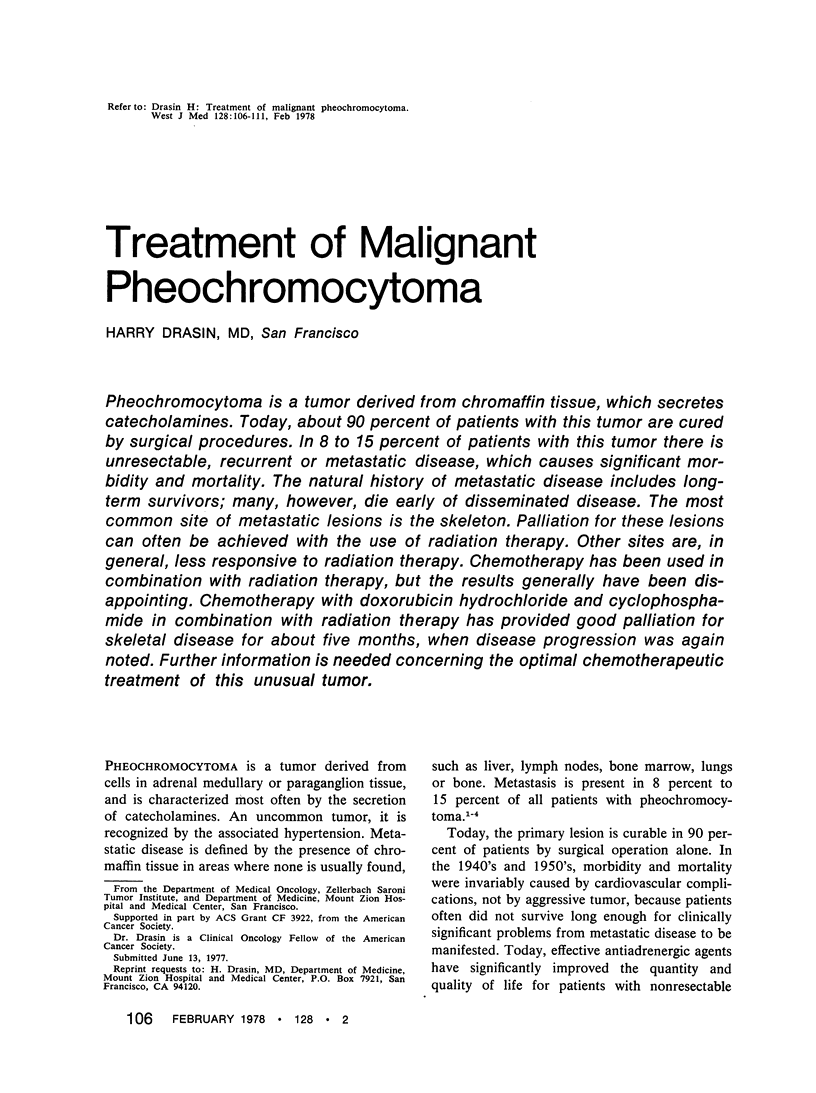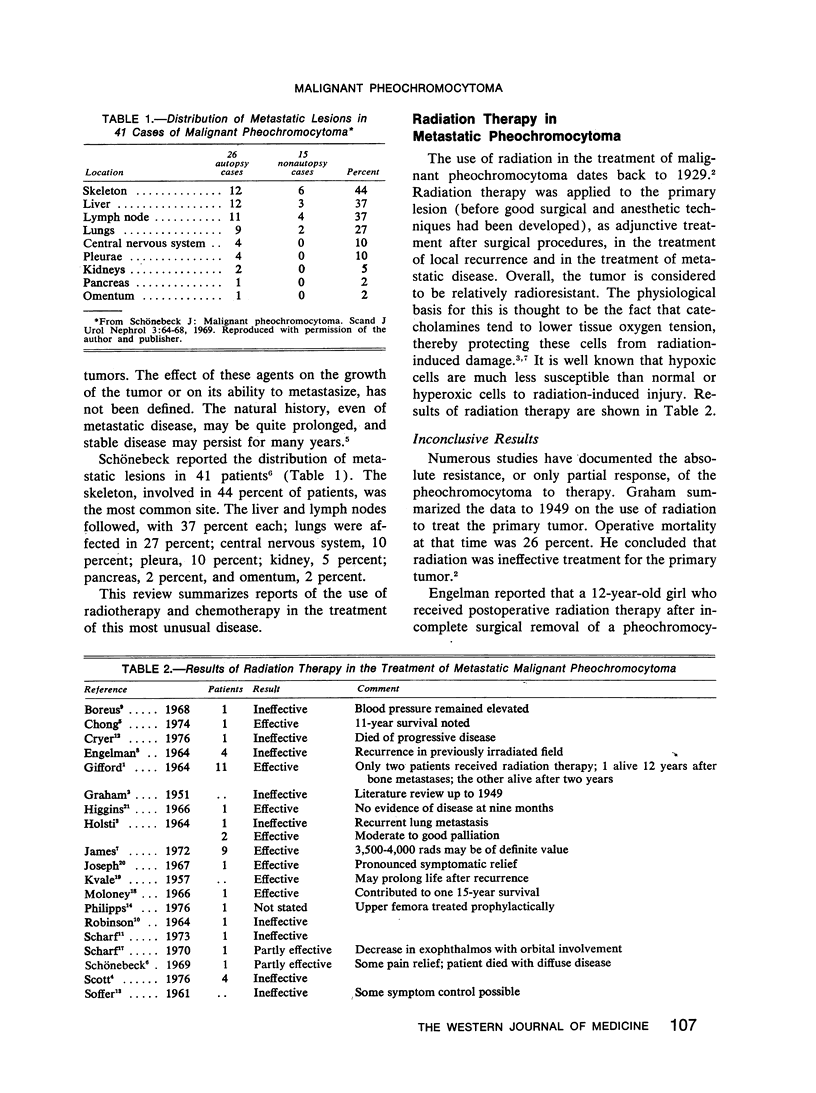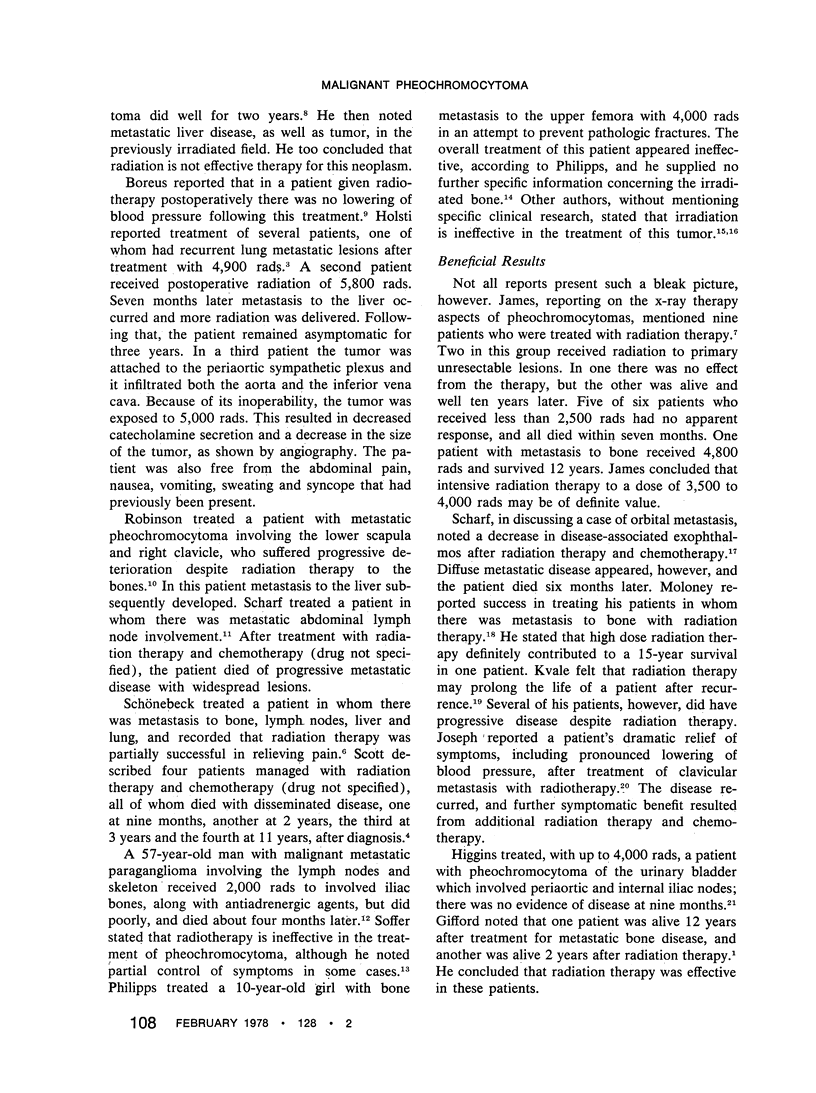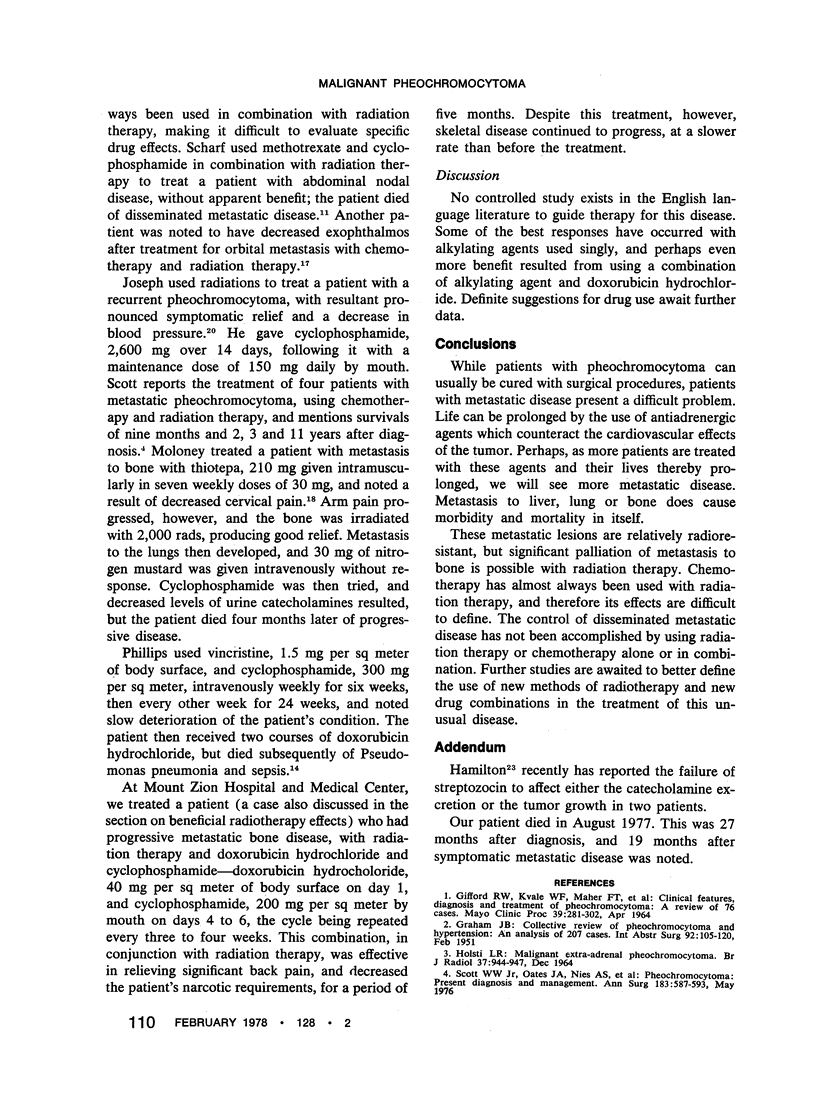Abstract
Pheochromocytoma is a tumor derived from chromaffin tissue, which secretes catecholamines. Today, about 90 percent of patients with this tumor are cured by surgical procedures. In 8 to 15 percent of patients with this tumor there is unresectable, recurrent or metastatic disease, which causes significant morbidity and mortality. The natural history of metastatic disease includes long-term survivors; many, however, die early of disseminated disease. The most common site of metastatic lesions is the skeleton. Palliation for these lesions can often be achieved with the use of radiation therapy. Other sites are, in general, less responsive to radiation therapy. Chemotherapy has been used in combination with radiation therapy, but the results generally have been disappointing. Chemotherapy with doxorubicin hydrochloride and cyclophosphamide in combination with radiation therapy has provided good palliation for skeletal disease for about five months, when disease progression was again noted. Further information is needed concerning the optimal chemotherapeutic treatment of this unusual tumor.
Full text
PDF





Selected References
These references are in PubMed. This may not be the complete list of references from this article.
- Boréus L. O., Broberger U., Nergårdh A., Zetterqvist P. Malignant pheochromocytoma in a child: treatment with a combination of alpha- and beta-adrenergic blockade. Acta Paediatr Scand. 1968 Jan;57(1):36–40. doi: 10.1111/j.1651-2227.1968.tb07283.x. [DOI] [PubMed] [Google Scholar]
- Chong G. C., ReMine W. H., Sheps S. G. Recurrent pheochromocytoma from direct peritoneal implantation. Report of two patients with 22-year survival periods. Minn Med. 1974 Dec;57(12):951–952. [PubMed] [Google Scholar]
- DAVIS P., PEART W. S., VAN'T HOFF W. Malignant phaeochromocytoma with functioning metastases. Lancet. 1955 Aug 6;269(6884):274–275. doi: 10.1016/s0140-6736(55)92694-5. [DOI] [PubMed] [Google Scholar]
- ENGELMAN K., SJOERDSMA A. CHRONIC MEDICAL THERAPY FOR PHEOCHROMOCYTOMA; A REPORT OF FOUR CASES. Ann Intern Med. 1964 Aug;61:229–241. doi: 10.7326/0003-4819-61-2-229. [DOI] [PubMed] [Google Scholar]
- GIFFORD R. W., Jr, KVALE W. F., MAHER F. T., ROTH G. M., PRIESTLEY J. T. CLINICAL FEATURES, DIAGNOSIS AND TREATMENT OF PHEOCHROMOCYTOMA: A REVIEW OF 76 CASES. Mayo Clin Proc. 1964 Apr;39:281–302. [PubMed] [Google Scholar]
- GRAHAM J. B. Pheochromocytoma and hypertension; an analysis of 207 cases. Int Abstr Surg. 1951 Feb;92(2):105–121. [PubMed] [Google Scholar]
- HOLSTI L. R. MALIGNANT EXTRA-ADRENAL PHAEOCHROMOCYTOMA. Br J Radiol. 1964 Dec;37:944–947. doi: 10.1259/0007-1285-37-444-944. [DOI] [PubMed] [Google Scholar]
- Hamilton B. P., Cheikh I. E., Rivera L. E. Attempted treatment of inoperable pheochromocytoma with streptozocin. Arch Intern Med. 1977 Jun;137(6):762–765. [PubMed] [Google Scholar]
- Higgins P. M., Tresidder G. C. Phaeochromocytoma of the urinary bladder. Br Med J. 1966 Jul 30;2(5508):274–277. doi: 10.1136/bmj.2.5508.274. [DOI] [PMC free article] [PubMed] [Google Scholar]
- James R. E., Baker H. L., Jr, Scanlon P. W. The roentgenologic aspects of metastatic pheochromocytoma. Am J Roentgenol Radium Ther Nucl Med. 1972 Aug;115(4):783–793. doi: 10.2214/ajr.115.4.783. [DOI] [PubMed] [Google Scholar]
- Joseph L. Malignant phaeochromocytoma of the organ of Zuckerkandl with functioning metastases. Br J Urol. 1967 Apr;39(2):221–225. doi: 10.1111/j.1464-410x.1967.tb09801.x. [DOI] [PubMed] [Google Scholar]
- KVALE W. F., ROTH G. M., MANGER W. M., PRIESTLEY J. T. Present-day diagnosis and treatment of pheochromocytoma; a review of fifty-one cases. J Am Med Assoc. 1957 Jun 22;164(8):854–861. doi: 10.1001/jama.1957.02980080024004. [DOI] [PubMed] [Google Scholar]
- Moloney G. E., Cowdell R. H., Lewis C. L. Malignant phaeochromocytoma of the bladder. Br J Urol. 1966 Aug;38(4):461–470. doi: 10.1111/j.1464-410x.1966.tb09736.x. [DOI] [PubMed] [Google Scholar]
- Pheochromocytoma: current concepts of diagnosis and treatment. Combined clinical staff conference at the National Institutes of Health. Ann Intern Med. 1966 Dec;65(6):1302–1326. [PubMed] [Google Scholar]
- Philipps A. F., McMurtry R. J., Taubman J. Malignant pheochromocytoma in childhood. Am J Dis Child. 1976 Nov;130(11):1252–1255. doi: 10.1001/archpedi.1976.02120120086016. [DOI] [PubMed] [Google Scholar]
- Scharf Y., Ben Arieh Y., Gellei B. Orbital metastases from extra-adrenal pheochromocytoma. Am J Ophthalmol. 1970 Apr;69(4):638–640. doi: 10.1016/0002-9394(70)91632-6. [DOI] [PubMed] [Google Scholar]
- Scharf Y., Nahir A. M., Better O. S., Koten A., Arieh Y. B., Gellei B. Prolonged survival in malignant pheochromocytoma of the organ of Zuckerkandl with pharmacological treatment. Cancer. 1973 Mar;31(3):746–750. doi: 10.1002/1097-0142(197303)31:3<746::aid-cncr2820310339>3.0.co;2-1. [DOI] [PubMed] [Google Scholar]
- Schönebeck J. Malignant pheochromocytoma. Scand J Urol Nephrol. 1969;3(1):64–68. doi: 10.3109/00365596909135383. [DOI] [PubMed] [Google Scholar]
- Scott H. W., Jr, Oates J. A., Nies A. S., Burko H., Page D. L., Rhamy R. K. Pheochromocytoma: present diagnosis and management. Ann Surg. 1976 May;183(5):587–593. doi: 10.1097/00000658-197605000-00016. [DOI] [PMC free article] [PubMed] [Google Scholar]


